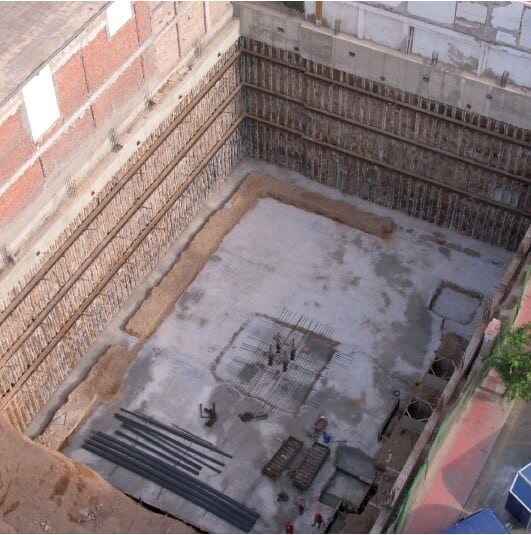Micropiles
Concept and characteristics
Micropiles are small diameter cylindrical holes (between 114 and 400mm), into which a tubular metal frame is introduced, normally with a high elasticity limit (also bar reinforcement is used). It is joined to the ground by the means of a pressure injection of cement grout or mortar.
Procedure
1.Boring
The technique used to bore for a micropile depends basically on the type of ground involved. While there are several boring procedures, the following are the most used:
- OD.
- ODEX.
- Rotation.
- Hammer rotopercussion at the head.
Although it is not necessary in some cases to protect the bore against internal ground collapse, it is common to use a recoverable casing, and sweeps with water and compressed air. If the ground is not stable for boring, it may be necessary to use waste tubing, which can substitute for or complement the reinforcing required. The bore is washed with water and/or pressurised air. If the reinforcement is tubular, which is the most-used, it goes into the bore once the washing is finished. Bar reinforcing is introduced once the bore is grouted.

2.Grouting
Grouting is done using the reverse circulation pumping technique for the cement or mortar.
For tubular reinforcement, pumping is done through the tube, to the bottom of the bore, then up through the annular space formed between it and the ground, shifting the bore detritus with it. If the tubing is itself the reinforcement, grouting is done following bore cleaning. When using reinforcement bars, the grouting is carried out after the washing, and the bar is introduced immediately afterward.
Applications
The applications are many, most particularly in all types of work involving reduced space or where large machines are not possible because of their excessive weight:
- Rehabilitation of all types of buildings.
- Underpinning.
- Foundation reinforcement in building extensions.
- Deep foundations on small plots.
- Support for existing foundations for basement excavation.
- Slurry walls in reduced spaces.
- Slope stabilisation on roads.
- Micropile umbrellas for tunnel openings.
- Deep foundations on ground not suitable for conventional piling.
